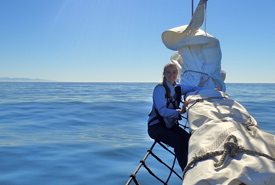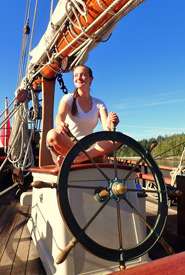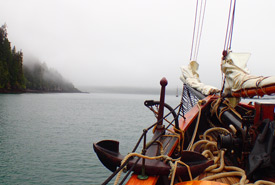Heard it from a Scout: Tips for safe sailing

Sarah out on the sailboat (Photo courtesy Scouts Canada)
Coast to coast, there are endless opportunities for sailing in Canada. From hauling the lines to watching the sails fill and being pulled across the water by the sheer force of the wind, sailing is an exhilarating experience and offers a unique connection to nature.
On a clear night, sailing is one of the most peaceful moments I’ve enjoyed. Beyond the city lights, the stars are so plentiful and bright it seems as if you are captured within a snow globe. This unique experience, among many others, is what makes sailing inherently captivating and such a popular pastime.

Acting as the skipper (Photo courtesy Scouts Canada)
I learned to sail with my Scout group during camping trips, and a few years later began going on multi-day trips. In 2013, I sailed for 10 days, with a group of six others, across the Adriatic Sea, starting in Croatia and weaving between islands until we reached Slovenia. In 2016, I joined the Sea and Life Training Society (SALTS) and, together with a crew of 38, sailed the west coast of Vancouver Island on a wooden tall ship.
Whether your goal is to sail freshwater lakes or the big blue ocean, learn how to be prepared and keep in mind some of the following tips:
Take a lesson
In preparation for a major sailing adventure, it’s necessary to learn the basic skills. Consider taking a sailing lesson or a joining a recreational sailing group to practise before your big expedition. Make your first sailing trip on an accessible, shallow body of water in a smaller vessel with someone with experience.
Watch the weather forecast
Keep an eye on the weather and wind forecast for a few days before your trip. For novices, it’s best to avoid sailing during heavy rain, strong winds or at night, as these conditions aren’t favourable while learning to sail. It’s better to postpone or even cancel a trip than to head out into potentially dangerous conditions.
Research and prepare a nautical first aid kit
First aid kits on boats are different from typical first aid kits used while camping or hiking. Nautical first aid kits include items such as rescue flares, water purification tablets and an emergency radio. Spend time researching and preparing your first aid kit before heading out on the water.

Views from the ship (Photo courtesy Scouts Canada)
Learn the ropes (and knots)
Before beginning an adventure, take some time to learn basic sailing terminology, how to read navigation charts and how to tie bowline, clove hitch, sheet bend and reef knots. Researching sailing terminology will help you better understand the vessel’s operation and the fascinating mechanics behind sailing.
Plan your fresh water supply
Having adequate drinking water is crucial to an enjoyable and safe sailing trip. For day trips, bring at least two litres of fresh drinking water per person. For multi-day trips, plan the route to include stops at marinas in order to replenish your water supply. Before leaving, inspect the condition of the vessel’s fresh water tank. Keep in mind that your fresh water supply needs to account for washing dishes and cooking.
Learn the protocols for overboard emergencies
Every minute counts during a person overboard emergency, especially in poor sailing conditions. It‘s critical that everyone on board be aware of what to do if someone falls overboard. Before beginning your trip, ask the skipper (captain) where the life rings and personal floatation devices are stored and the procedure if someone falls overboard, and be sure to practise it with everyone onboard.
Take seasickness medication before you feel sick
Seasickness medication does not work if you are already feeling sick — I’ve learned this the hard way. If you suspect you might get seasick, take medication before you board the vessel.
"Heard it from a Scout" is written by members of Scouts Canada’s Youth Spokesperson program. This post was authored by Sarah Savić Kallesøe.


